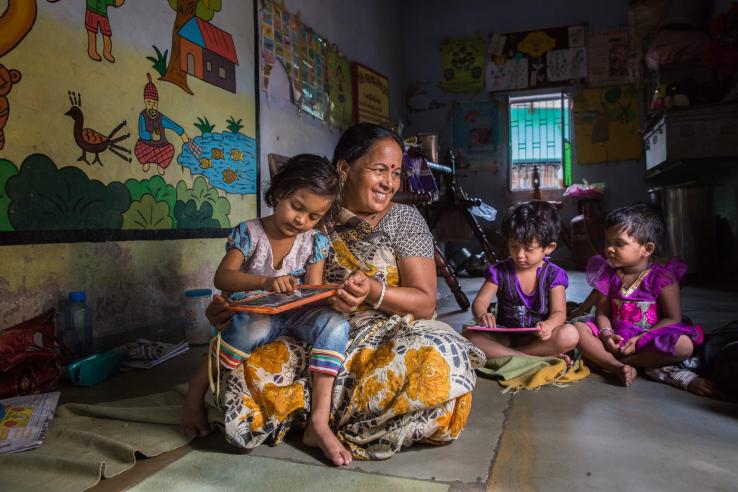
Access to childcare to improve women’s economic empowerment

Résumé
Globally, women engage in the labor force at much lower rates than men. In 2022, women’s labor force participation rate worldwide was 50 percent compared to 80 percent of men 1. One likely contributor to the gender gap in participation is the disproportionate childcare burden that is placed on women. As of 2018, women around the world conducted over three-quarters of total unpaid childcare work, work that is essential to economic and societal well-being but takes up a substantial portion of women’s time. 2 A 16-country survey found that before the Covid-19 pandemic, 24 percent of women with a child under the age of 6 years old spent nine or more hours a day on childcare compared to just 7 percent of men. The gap has only increased as a result of the pandemic. 3
Women globally are outside the workforce due to household responsibilities much more frequently than men (606 million women in 2018 versus 41 million men). 2 Likewise, on average women-owned businesses earn lower profits than those owned by men, which may be due in part to disproportionate childcare responsibilities. 4 Besides enhancing women’s economic agency, addressing gender disparities in workforce participation could lead to a significant gain in economic output. Thus, providing access to childcare could help women achieve greater economic parity and enhance their agency and could also lead to a substantial boost to the global economy.
This review of nine randomized evaluations of childcare interventions from eight low- and middle-income countries found that access to childcare increased women’s labor force participation but only in cases where there were no additional barriers to women’s employment outside the home (e.g., restrictive gender norms or lack of employment opportunities). The evidence also suggests that childcare may enable women to be more productive in their existing jobs and businesses or shift to more desirable work that is not compatible with childcare responsibilities. The interventions included in this policy insight vary in target age ranges and in modalities of childcare (including vouchers for private childcare, publicly provided daycare, and public after-school childcare). While further research is needed to compare implementation models and to measure other potential noneconomic benefits of reducing the childcare burden for women such as improved mental health or empowerment, emerging evidence suggests that access to childcare is a promising intervention to support women’s economic status in many but not all contexts.
Résultats
Access to childcare often increases mothers’ employment activities by freeing up their time.
In five studies, provision of childcare programs increased women’s employment, ranging from a 5 to 47 percent increase. [1][2][3][4][5] In Chile, offering free after-school care to school-aged children increased the probability of mothers working at least one month per year by 3.4 percentage points, from 71.6 percent in the comparison group (a 5 percent increase). [1] In Kenya, women who were offered vouchers for free childcare for children ages 1 to 3 years old were 8.5 percentage points (17.3 percent) more likely to be employed, on average. [2] In both studies, the impacts on labor force participation and/or employment were even greater for women who had not been working before the program was implemented.
However, fewer studies could detect substantial impacts on income or on downstream measures of women’s empowerment. Of the five studies that found positive impacts on women’s employment outcomes, only one found positive impacts on women’s and/or households’ income (although two of these studies did not report on income outcomes). [2] Likewise, while improved economic outcomes as a result of childcare could improve women’s empowerment through improved agency, there were no discernible impacts on household decision-making or other measures of agency in the few studies that measured those outcomes. [6][2][7] Income and empowerment impacts may have been undetectable in some studies due to methodological limitations.
Furthermore, childcare may have very different impacts across subgroups of women. For example, it had mixed impacts on labor force participation and income for single versus married women [2][8], for women with younger children who were eligible for the childcare program [6], and for women with or without additional small children in the home who were ineligible for the childcare program being evaluated. [8][1] Thus, researchers will need to implement sufficiently large sample sizes to detect impacts on income within and across subgroups. To fully measure the (cost-) effectiveness of childcare, more research is needed to precisely measure the downstream impacts of childcare beyond employment and income, such as agency and mental health.
When childcare does not lead to improved employment outcomes, it may be due to other factors being the primary barriers to employment (such as limited job opportunities or strict gender norms against women's work) or due to low perceived or actual quality of childcare.
Barriers to women’s work outside the home other than childcare may limit childcare’s transformative effects. In regions where there are gender norms against women working outside the home or limited acceptability of using childcare services, providing access to childcare may not result in the use of these services. For example, in Egypt women were offered either 25 or 75 percent cost subsidies for childcare (with and without additional employment services). Only 1.4 and 4.2 percent of women, respectively, used the subsidies, which could partially explain the limited impacts that the subsidies had on their job search activities. Researchers suggested that the low take-up may have been due to other barriers that Egyptian women faced, such as limited work opportunities and norms around childcare and women’s work (e.g., only 66 percent of women and 41 percent of men in this study believe it’s acceptable for a woman to leave a child at a nursery to go to work). Many mothers in this study also cited concerns about the safety and quality of care as a reason for not using the childcare subsidies. Addressing only one or two of these barriers to women’s work may not have been enough. [9]
In India, women were offered access to affordable community-based daycare centers. Despite high take-up (52.3 percent of women in villages with community daycares used childcare, 43 percentage points more than women in comparison villages), access to the daycare had somewhat limited impacts on employment and no impacts on income. Researchers suggested that patriarchal norms and/or limited employment opportunities could have limited the impacts of access to childcare on women’s economic outcomes. [4]
Additionally, in contexts with a large gender pay gap favoring men, it could make financial sense for a household to lessen the father’s household childcare burden, rather than the mother’s, in order to free up their time for more paid work. In Uganda, when households were offered childcare subsidies, men in couples were 9 percentage points more likely to be in wage work (33 percent higher than the comparison group) and increased their work hours by 21 hours (a 30 percent increase from the comparison group). However, childcare did not lead to increased earnings or labor supply for women in couples. [8] Policymakers who are considering childcare as a means to increase women’s economic outcomes should consider potential barriers to women’s employment such as gender norms, the labor market conditions, household dynamics, and the perceived or actual quality of childcare.
Childcare may improve economic welfare beyond increasing labor supply by enabling women to be more productive at work because they no longer need to bring their children to work or can shift to more desirable work.
Access to childcare can impact mothers’ economic agency beyond increasing the amount that they work. Childcare seems to also provide important support to some women who are already working. In Uganda, women with children aged 3 to 5 years who were offered one year of full-time subsidies for private childcare centers increased their business revenues by 47 percent on average compared to women who were not offered the childcare subsidies. The increase in revenues occurred despite no increase in their labor supply, productive assets, or number of employees on average. This effect was driven mainly by single mothers, who did increase their labor supply and their productivity when offered childcare. [8] Non-experimental evidence provides important insights on this point: researchers have documented a profit gap between self-employed women with young children and those who do not have young children in Uganda, where women entrepreneurs who bring a young child to work earn 48 percent less than women who do not. 4
In some cases, childcare may improve women’s welfare by enabling them to work less rather than more and without losses to income. In Kenya, single mothers could reduce their working hours when offered subsidized childcare without reducing their earnings. Descriptive analyses found that single women shifted away from work such as laundry and small-scale sales, which have more flexible hours and are more compatible with simultaneous childcare, and shifted toward jobs with fixed hours and higher pay, such as in government-sponsored employment and in the service sector. [2] This evidence suggests that some women who are already participating in the workforce without childcare may still benefit from childcare provision by increasing their productivity in their businesses or by accessing better work opportunities.
Childcare may also have important welfare impacts on other household members besides the mothers by changing who takes care of the child.
While most studies did not measure the impact of childcare on other household members, evidence from Brazil suggests that childcare could have an important impact beyond mothers, perhaps especially in places where multigenerational households are more common. Researchers found that while childcare didn’t increase mothers’ employment, grandparents and siblings aged 15 and over were more likely to be employed and have higher earnings four years after the daycare program was offered. [10] Access to childcare may also impact a household’s decision related to the father’s labor supply, as in Uganda. [8] Cost-effectiveness analysis that only considers the impact of childcare on mothers’ employment outcomes may underestimate the return to childcare interventions. Thus, measuring the impacts of childcare on all household members is important to accurately measure the cost-effectiveness of childcare interventions.
Not providing access to childcare for children at all ages may limit mothers’ ability to participate in paid work.
Mothers may need coverage for all of their children in order to enter the workforce and benefit from childcare provision. In Chile, researchers found that providing free after-school care to children aged 6 to 13 years old led families to increase their use of a preexisting free daycare program for children who were not yet school aged by 5.5 percentage points (an 82 percent increase from the comparison group). [1] In Uganda, researchers found that while childcare allowed mothers to be more productive in their businesses on average, mothers with young children at home who were not eligible for childcare did not have higher business income. When the child in the daycare was the youngest in the family, however, the mother’s business income increased by 78 percent on average. [8] These findings suggest that women need coordinated care for all their children in order to join the labor market or achieve success in their businesses. In addition to providing childcare for all children, future research should examine how the duration of childcare may impact its effectiveness in enabling women’s participation in the labor force.
J-PAL Policy Insight. 2023. "Access to Childcare to Improve Women’s Economic Empowerment." Cambridge, MA: Abdul Latif Jameel Poverty Action Lab
Martínez, Claudia, and Marcela Perticará. 2017. “Childcare Effects on Maternal Employment: Evidence from Chile.” Journal of Development Economics 126: 127–137.
Clark, Shelley, Caroline W. Kabiru, Sonia Laszlo, and Stella Muthuri. 2019. “The Impact of Childcare on Poor Urban Women’s Economic Empowerment in Africa.” Demography 56, no. 4: 1247–1272.
Hojman, Andrés, and Florencia Lopez Boo. 2022. “Public Childcare Benefits Children and Mothers: Evidence from a Nationwide Experiment in a Developing Country.” Journal of Public Economics 212.
Nandi, Arijit, Parul Agarwal, Anoushaka Chandrashekar, and Sam Harper. 2020. “Access to Affordable Daycare and Women’s Economic Opportunities: Evidence from a Cluster-Randomised Intervention in India.”Journal of Development Effectiveness 12, no. 3: 219–239.
Martinez, Sebastian, Sophie Naudeau, and Vitor Pereira. “Preschool and Child Development under Extreme Poverty: Evidence from a Randomized Experiment in Rural Mozambique.” World Bank Policy Research Working Paper, December 2017.
Ajayi, Kehinde F., Aziz Dao, and Estelle Koussoubé. “The Effects of Childcare on Women and Children: Evidence from a Randomized Evaluation in Burkina Faso.” World Bank Policy Research Working Paper 10239, November 2022.
Richardson, Robin A., Sam Harper, Norbert Schmitz, and Arijit Nandi. 2018. “The Effect of Affordable Daycare on Women’s Mental Health: Evidence from a Cluster Randomized Trial in Rural India.” Social Science and Medicine 217: 32–41.
Bjorvatn, Kjetil, Denise Ferris, Selim Gulesci, Arne Nasgowitz, Vincent Somville, and Lore Vandewalle. “Childcare, Labor Supply, and Business Development: Experimental Evidence from Uganda.” Working Paper, December 2022.
Caria, Stefano, Bruno Crepon, Hala ElBehairy, Noha Fadlalmawla, Caroline Krafft, Abdelrahman Nagy, Lili Mottaghi, Nahla Zeitoun, and Souraya El Assiouty. “Child Care Subsidies, Employment Services and Women’s Labor Market Outcomes in Egypt: First Midline Results.” Working Paper, July 2022.
Research Paper | J-PAL Evaluation Summary
Attanasio, Orazio, Ricardo Paes de Barro, Pedro Carneiro, David Evans, Lycia Lima, Pedro Olinto, and Norbert Schady. “Public Childcare, Labor Market Outcomes of Caregivers, and Child Development: Experimental Evidence from Brazil.” Working Paper, November 2022.

